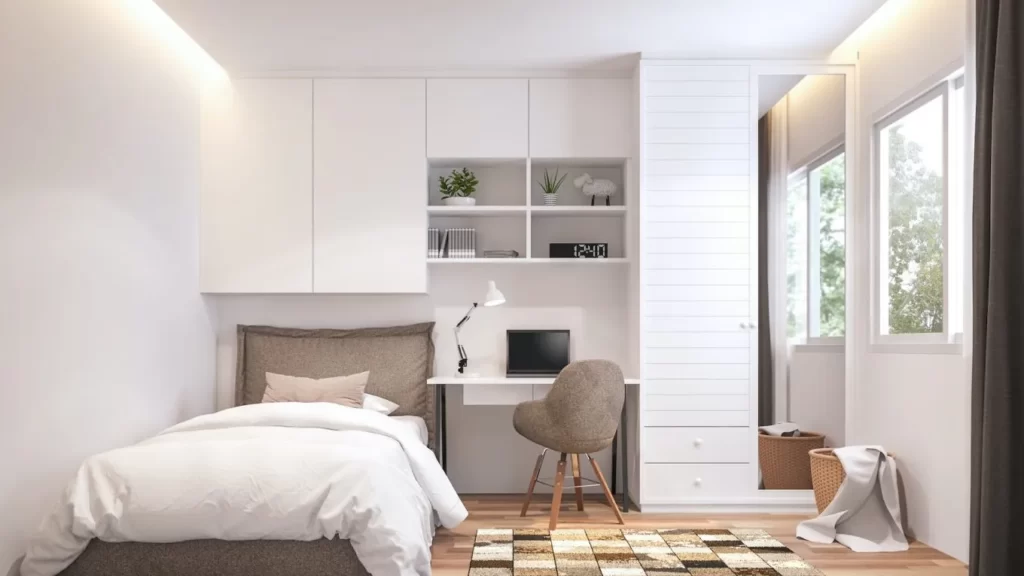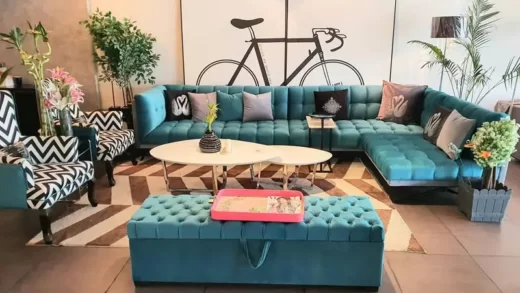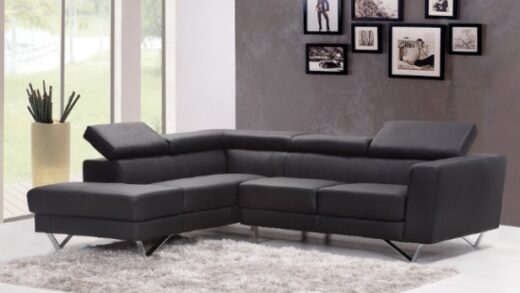Small bedrooms are one of the most prevalent decorating problems, so you’re not alone if you have one. Since you can only increase the square footage by remodeling, it’s a good thing that there are decorating techniques to make your bedroom appear bigger than it is.
Table of Contents
Several Steps Make A Small Bedroom Look Bigger
1. Use Vertical Space
When working with a small space, consider the vertical. Even if you don’t have much floor space, using the walls all the way to the ceiling will help you make better use of what you do have while also drawing attention upward, which will give the illusion that the room is larger.
Although they are a great way to increase storage, interest, and visual space in a bedroom, built-in shelves that reach all the way to the ceiling aren’t an option for everyone. Purchasing a tall headboard and hanging decorations above the bed to fill the entire space is a simple substitute.
2. Choose Furniture With Legs
To make the bedroom feel airy and open, give your furniture some height with legs. Even though not all of your furniture needs to be on legs, try to have at least one tall piece, such as your dresser, bed, or nightstand. Given that the majority of the furniture is raised on thin legs, the midcentury modern decorating style is ideal for small rooms. Your room will appear larger the more the floor and wall are visible. The bed frame in this room has legs that aren’t particularly tall but add just enough height to help open up the room.
3. Match Window Treatments To The Walls
While blinds or drapes that contrast with the walls look great in large bedrooms, it is preferable to match your window treatments and walls in a small bedroom. As a result, the bedroom appears a little bit larger than it actually is by deceiving the eye into moving around the room. Observe how the paneling in this tiny, white bedroom gives the walls some texture while blending in with the windowpane. That way, you can increase interest without making the area appear smaller.
4. Exaggerate Vertical Space With Vertical Panels
Using vertical panels or stripes to exaggerate the room’s ceiling height can make a small bedroom appear larger whether or not your home has high ceilings. This is obvious in this space, but even wallpaper with vertical stripes will work.
Designed by Anderssen & Voll, this Muuto mirror creates reflections, too, maximizing the light in the room. Your bedroom will feel larger once you learn how to use mirrors effectively, and they’re also a cost-effective choice. Simply positioning a mirror so that it can reflect a window will instantly make a room feel bigger.
5. Keep Furniture In Scale
Small rooms don’t necessarily require tiny furniture, but you will need to find pieces that are the right size for your room and have a scale that matches. Two tiny nightstands on either side of a king-sized bed look silly.
Instead, pick a bed size that enables you to fit at least one or two nightstands big enough to compete with the mattress beside it, like this bedroom. Your dresser should be the same size as the nightstand; in a small space, a tall, narrow piece frequently works better than a wide, short one.
6. Use Sconces By The Bed
Install sconces above and slightly to the side of your headboard as opposed to using up space on your nightstand with bedside lamps. This helps to create a sense of openness and airiness in the space, draw the eye upward, and lessen visual clutter around your bed. The light can be moved to exactly where it is needed and then pushed back when you are finished reading, making adjustable sconces ideal for reading at night.
7. Create A Nook Bed To Fake Square Footage
Small bedroom layouts can be challenging, so if you’re struggling with ideas for how to set up a small bedroom, take a look at this: section off the sleeping area with a nook bed, leaving the rest of the floor in the middle of the room free.
These might be a step forward for walls, but they also produce a room that is incredibly tidy and space-efficient because storage can be concealed within the nook, clearing the space outside of it and making it calmer and less cluttered. Additionally, they are incredibly comfortable for sleeping in.
8. Try A Light Palette
White is said to open up a space, and in most cases, this is true. Your bedroom does not, however, have to look like an operating room. Even though you don’t have to use all white when decorating, sticking to a gentle, light color scheme is beneficial. Small rooms are perfect for pastels and hushed tones of gray.
Try combining white with one vivid or mid-tone color, like the blue and white in this example. Stick with cool colors for the greatest impact; soft shades of blue, green, and purple help open up a space, while warmer hues have the opposite effect.

9. Stick To Thin Or No Drapes
Take advantage of natural light; it’s one of the best tools you have for creating the illusion of space. If you can keep your windows bare and unadorned, it can give the impression that your room is connected to the outside space, which will make it appear larger. You can use curtains if you still want some privacy; just try to choose ones that are thinner while letting light through.
10. Try A Mostly White Color Scheme
A small space can feel airy and spacious by using white color schemes. You can experiment with texture and shade to see what suits you the best rather than keeping every wall the same sterile color. Without cramping the space or the style, lighter neutral accents, like the wooden bed frame in this photo, can add a tiny bit of diversity.
11. Try Stylish Bunk Beds
Multiple beds may not always fit comfortably in smaller spaces, creating a claustrophobic atmosphere. Bunk beds can be an easy way to use some of the vertical space you have available without taking up extra space in your home. However, bunk beds don’t have to be plain; there are many stylish and contemporary options that will impress your children or even overnight visitors.
12. Try Floating Nightstands
While floating shelves may be a concept you are already familiar with, what about floating nightstands? Installing the floating versions makes plenty of extra space visible in place of tables with large legs or boxy styles that take up floor space. While still providing a place for a lamp or alarm clock, this creates the appearance of more space.
13. Try A Different Rug Placement
We are aware that rugs can be crucial to a layout and design, and that certain tricks can alter the mood of the entire room. Your eye may be tricked into thinking there is more space than there is by placing your rug at the foot of the bed and having only half of the bed rest on it. You can also use the trick in other parts of the room, placing only the front or the back legs of pieces of furniture on the rug for the same idea.
What Colors Grow Space In A Small Bedroom?
Light-reflecting hues, such as the vast array of whites, pastels, and subdued primaries, are often the ones that make a small bedroom appear larger.
When figuring out how to make a small bedroom appear larger, don’t just rely on color; paint and bedroom wallpaper ideas will also have an impact. Those with a soft sheen reflect space-enhancing light from the ceiling and walls, which is particularly helpful in small spaces. But keep in mind that sheens, as opposed to matte finishes, will highlight flaws more, so plasterwork must be in good condition.
How Should Furniture Be Placed In A Small Bedroom?
Maintaining a straightforward layout is the best way to set up a bedroom. The main wall of the room, which is typically the largest or the one to which your eyes are drawn when you enter, is the ideal place for your bed.
As we previously mentioned, if you have the room, position your bed in the middle of the main wall. For the room to remain open and have a smooth flow, you will want some room to walk on each side.
If you have alcoves, use them for storage by placing furniture there. If not, simply place the larger storage items on the side of the room opposite the bed to balance the space.



